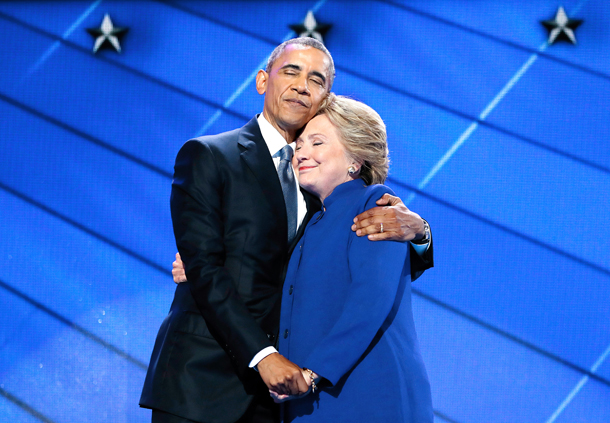Two different conventions

President Barack Obama hugs Democratic Presidential candidate Hillary Clinton after addressing the delegates during the third day session of the Democratic National Convention in Philadelphia, July 27, 2016. [AP/NEWSIS]
“The Democratic National Convention in the Philadelphia this week reconfirmed the power of American democracy. Bernie Sanders, the leftist presidential candidate who created a phenomenon throughout the primary, gave a passionate 30-minute speech to support his rival, Hillary Clinton, to demonstrate the reconciliation of the party. Many party members and supporters with various backgrounds were given opportunities to deliver speeches at the convention, once again upholding the tradition of the Democratic Party that it is engaging many of the society’s minorities. Most of all, the Democratic Party proudly showed off its openness by presenting American voters the unprecedented chance to elect a woman president, after producing the first African-American president.”
None of the observations would be trivial. But I was particularly intrigued by the 2016 Democratic Party Platform, announced during the convention week, as I watched the event through media over the past days. Differently from the flamboyant but irresponsible pledges from Korean political parties, pledges have grave importance in the U.S. society, where a contract is signed with utmost prudence and enforced strictly. For example, an elementary school in the United States hands out a regulation book to its newly admitted first-graders. If the Clinton administration will launch, the platform will serve as a contract with American citizens for the next four years.
Clinton’s 51-page, 13-chapter party platform is aimed at one key goal of raising incomes and restoring economic security for the missile class by increasing incomes, creating good jobs, controlling the greed of financial industry and activating a fair economy. Increasing incomes and creating jobs are familiar pledges to the Koreans, but they actually have a rare point that we cannot find in our politics.
The 2012 Democratic Platform, presented by President Barack Obama during his reelection campaign four years ago, stated its primary policy goal as “rebuilding middle class security.” In other words, Obama and Hillary, who fiercely competed for the Democratic presidential nomination in 2008, maintain the firm consistency toward America’s challenges in the era of polarization. Such a consistency is referred as systemization of a political party by Korean political scientists.
Let’s look into our reality. Perhaps most of the Korean people are not aware of it, but the ruling Saenuri Party will hold its national convention in 10 days. On Aug. 27, the main opposition Minjoo Party of Korea will hold its convention to elect a new leadership. While the national conventions of the U.S. political parties are an arena of participation open to a variety of supporters and an event where the current power is handing over the policy goal to the future power, national conventions of Korean political parties are nothing but an arena of internal power struggle. In Korean parties’ conventions, there are no people, no energy and of course, no thought for the future.
Comparing our political parties to American political parties is also stereotypical. But there is one thing we must remember.
Just 50 years ago, American political parties held their national conventions with only middle-aged White men. The turbulence in 1968 changed everything to reshape the parties. Since the end of the World War II, stability of the United States was maintained for decades, but it collapsed around 1968. After the Great Depression, the worst economic crisis came, and extreme confrontations and clash of values shook the American society amid the deepening crisis from the Vietnam War.
The Democratic National Convention in Chicago in 1968 was the classic example of chaos and disorder. In the face of a crisis where the system and ideology that led the American golden age in the post-war era were shaken, American political parties gave up the established right as the league of the middle-aged White men and transformed to become today’s open party. Since then, the national conventions of the parties became a political festival where women, youngsters, different ethnic groups and minorities participate.
Koreans are also standing at the center of a great transformation. We all worry about the fourth industrial revolution, a gap society and hopelessness, but our political parties treat the concerns nothing but another stereotypical story.
Translation by the Korea JoongAng Daily staff.
JoongAng Ilbo, July 29, Page 35
*The author is a professor of political science at Chung-Ang University.
Juang Hoon










with the Korea JoongAng Daily
To write comments, please log in to one of the accounts.
Standards Board Policy (0/250자)